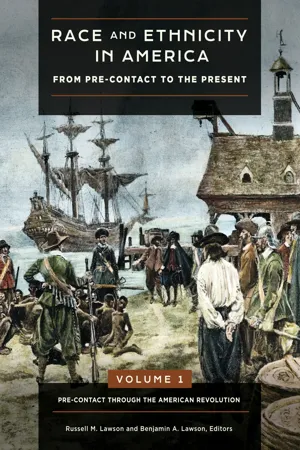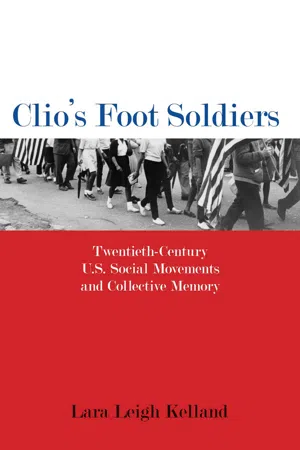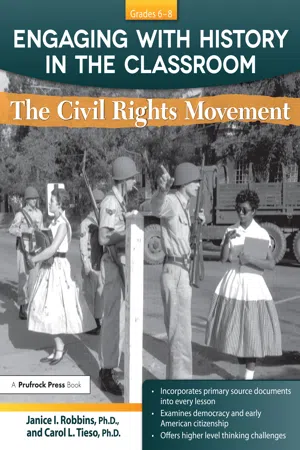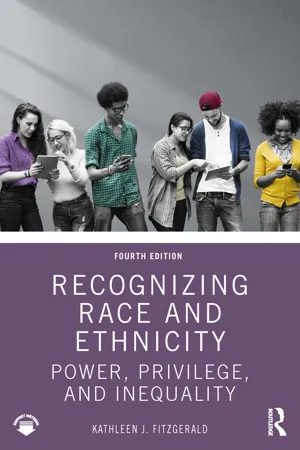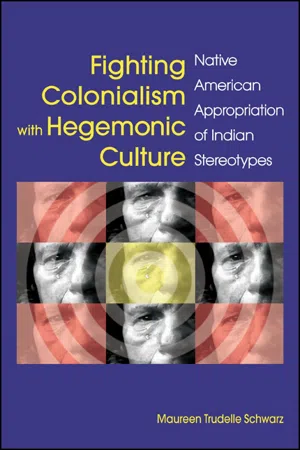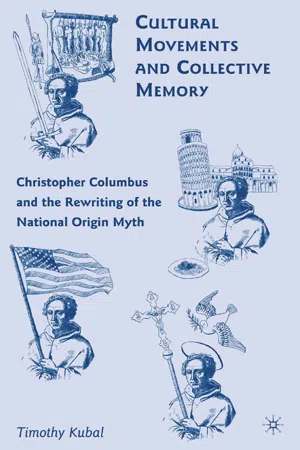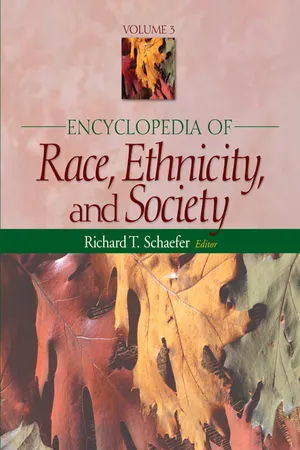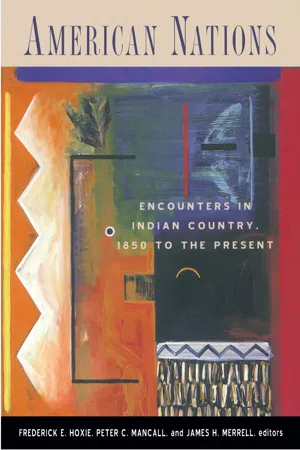History
American Indian Movement
The American Indian Movement (AIM) is a Native American civil rights organization founded in 1968 to address systemic issues facing Indigenous peoples in the United States. AIM sought to combat racism, poverty, and police brutality, and to promote the preservation of Native American culture and traditions. The movement gained attention for its advocacy and activism, including the occupation of Wounded Knee in 1973.
Written by Perlego with AI-assistance
Related key terms
1 of 5
10 Key excerpts on "American Indian Movement"
- eBook - ePub
Race and Ethnicity in America
From Pre-contact to the Present [4 volumes]
- Russell M. Lawson, Benjamin A. Lawson, Russell M. Lawson, Benjamin A. Lawson(Authors)
- 2019(Publication Date)
- Greenwood(Publisher)
In the early 1970s, AIM opened a number of Survival Schools to serve as an educational alternative to the dominant school system that the Native community felt did not serve the needs of Native children. The educational crisis of Native children in the Twin Cities public school system and elsewhere was manifest in abysmal dropout rates, high truancy, socioeconomic alienation, and ignorance, racial bias, and outright hostility from fellow students, teachers, and administrators toward cultural difference. Native Twin Cities’ residents felt that assimilationist pressures to conform to dominant society ultimately eroded Native students’ cultural identity and self-worth. Two Survival Schools were founded in 1972: the Heart of the Earth Survival School in Minneapolis in January as well as the Red School House in St. Paul in spring of the same year. The Heart of the Earth Survival School was in existence until 2008 when it was forced to close due to financial discrepancies; the Red School House was in existence until 1995. AIM Survival Schools were recognized as places strengthening Native communities and reclaiming indigenous knowledge systems and cultural identities. As Native community-controlled institutions, they were also considered to be vehicles of indigenous decolonization efforts through educational self-determination.The American Indian Movement and Protest ActivismThe between 1969 and 1973, AIM became one of the most prominent Native activist organizations with numerous chapters across the nation. The militant Nativeness that AIM members embodied at various protest events was accompanied by considerable media attention, frequently propelling AIM’s leaders into the spotlight of news networks and leaving the grassroots efforts of local people or women activists unnoticed. However, to mainstream America, Native Americans were invisible. Their small population in relation to other minorities and the cross-cultural situatedness of Native communities within America (either on the fringes of society on remote reservations in the American heartland or in urban areas) left Native Americans invisible and without a voice. Native activists had to be particularly concerned to gain the media’s attention, something that was frequently only possible through militant protest.The use of the media to draw attention to Native issues played a significant role throughout AIM’s existence. Frequently, AIM’s protest activism—its agenda, its tactics, and its strategies—revolved around drawing media attention to their grievances. Media coverage functioned to air Native grievances, to draw attention to public figures of Indian Affairs, and to transmit information about new forms of protest and contention to other potential protesters. Dennis Banks (Ojibwe) and Clyde Bellecourt (Ojibwe), the organization’s cofounders, as well as a number of other activists that joined later—Russell Means (Lakota), Carter Camp (Ponca), John Trudell (Sioux), and Vernon Bellecourt (Ojibwe), Clyde’s brother—would eventually become the public faces of AIM. Dennis Banks and Russell Means are probably the most photographed Native Americans of the twentieth century. Male AIM members became perhaps most notorious for its imagery of hypermasculine warriors that attracted nationwide news media attention. - eBook - ePub
Clio's Foot Soldiers
Twentieth-Century U.S. Social Movements and Collective Memory
- Lara Leigh Kelland(Author)
- 2018(Publication Date)
- University of Massachusetts Press(Publisher)
6 Some private, some facilitated by the Bureau of Indian Affairs (BIA), boarding schools removed Native youth from their tribal and familial contexts and sought to acculturate the next generation of Native communities in the ways of hegemonic American society, oftentimes through significant brutality and neglect. Boarding school policy prohibited the use of tribal languages, and school leadership usually understood that part of their institutional mission was to eradicate the traditional cultural practices of Native communities. As such, boarding schools increasingly became a target of Native activism during the twentieth century, and the schools served as both a potent symbol of the need for self-determination and cultural autonomy and a touchstone for the cultural activism engaged in this chapter.Arguably the most well-known manifestation of Native resistance in the twentieth century emerged in 1968 as the American Indian Movement (AIM). Building on the Pan-Indian consciousness that emerged in city centers during the earlier decades of urban relocation and community-building, movement leadership framed contemporary political struggles in the long history of Native/U.S. relations. Specifically, AIM activists sought “to halt America’s longest war, which has continued for 483 years against the Native, sovereign, indigenous people; against our culture and our spiritual way of life; and against our Mother Earth.”7 In both outward-facing press releases and internal movement discourse, AIM activists framed their actions with a well-integrated sense of the interconnectedness of past, present, and future anticolonial resistance.Education and Self-Determination
Indigenous activists had espoused sovereignty as a political goal and organizing principle for Native communities for much of the twentieth century. Although the founding of AIM in Minneapolis in July 1968 institutionalized Red Power, significant intellectual and activist underpinnings predated the organization’s formation by a few decades.8 The first long-lasting Pan-Indian political organization, the National Congress of American Indians (NCAI), was founded in 1944. Organized by boarding school graduates who had close ties to their individual tribes, early NCAI members had transformed the experience of being educated in multi-tribal environments into the basis for the Pan-Indian identities that would solidify in the following decades. Initially organized in response to BIA initiatives, one of NCAI’s most significant outcomes was on the cultural level, namely the production and institutionalization of an early Pan-Indian identity and consciousness.9 - eBook - ePub
Engaging With History in the Classroom
The Civil Rights Movement (Grades 6-8)
- Janice I. Robbins, Carol L. Tieso(Authors)
- 2021(Publication Date)
- Routledge(Publisher)
At the core of the movement is Indian leadership under the direction of NeeGawNwayWeeDun, Clyde H. Bellecourt, and others. Making steady progress, the movement has transformed policy making into programs and organizations that have served Indian people in many communities. These policies have consistently been made in consultation with spiritual leaders and elders. The success of these efforts is indisputable, but perhaps even greater than the accomplishments is the vision defining what AIM stands for.Indian people were never intended to survive the settlement of Europeans in the Western Hemisphere, our Turtle Island. With the strength of a spiritual base, AIM has been able to clearly articulate the claims of Native Nations and has had the will and intellect to put forth those claims.The movement was founded to turn the attention of Indian people toward a renewal of spirituality which would impart the strength of resolve needed to reverse the ruinous policies of the United States, Canada, and other colonialist governments of Central and South America. At the heart of AIM is deep spirituality and a belief in the connectedness of all Indian people.During the past thirty years, The American Indian Movement has organized communities and created opportunities for people across the Americas and Canada. AIM is headquartered in Minneapolis with chapters in many other cities, rural areas and Indian Nations.AIM has repeatedly brought successful suit against the federal government for the protection of the rights of Native Nations guaranteed in treaties, sovereignty, the United States Constitution, and laws. The philosophy of self-determination upon which the movement is built is deeply rooted in traditional spirituality, culture, language and history. AIM develops partnerships to address the common needs of the people. Its first mandate is to ensure the fulfillment of treaties made with the United States. This is the clear and unwavering vision of The American Indian Movement.It has not been an easy path. Spiritual leaders and elders foresaw the testing of AIM’s strength and stamina. Doubters, infiltrators, those who wished they were in the leadership, and those who didn’t want to be but wanted to tear down and take away have had their turns. No one, inside or outside the movement, has so far been able to destroy the will and strength of AIM’s solidarity. Men and women, adults and children are continuously urged to stay strong spiritually, and to always remember that the movement is greater than the accomplishments or faults of its leaders. - eBook - ePub
Recognizing Race and Ethnicity
Power, Privilege, and Inequality
- Kathleen J. Fitzgerald, Kathleen J Fitzgerald(Authors)
- 2023(Publication Date)
- Routledge(Publisher)
Urban Indians faced all the challenges other urban minorities faced, such as poverty, police brutality, and unemployment, but they also had unique challenges that stemmed from being disconnected from their tribal cultures and feeling alienated from the white, mainstream culture. Supratribal Indian organizations, those representing Indians of various tribes, emerged to address the needs of Native Americans, specifically the American Indian Movement (AIM), which was founded in Minneapolis in 1968, and the National Congress of American Indians, founded by Indian veterans of World War II.Source: Courtesy of the Library of Congress.Image 6.5Tipi with a sign reading “American Indian Movement” on the grounds of the Washington Monument in Washington, DC, during an American Indian organized protest known as the Longest Walk.Red Power activism began as a Native youth movement, specifically with the founding of the National Indian Youth Council in 1961. While the role of youths in the Red Power movement was not different from other social movements of the era, Native youth were unique in that they were not rebelling against their elders. Instead, they were interested in upholding tribal traditions (Shreve 2011 ).Indian activists engaged in numerous high-profile events to draw attention to their ongoing discrimination and oppression; almost all involved the occupation of national monuments, landmarks, or government offices. These locations are significant because they are part of the collective memory of a nation, “that set of beliefs about the past which the nation’s citizens hold in common and publicly recognize as legitimate representations of their history” (Rhea 1997 :2). At a basic level, Native people challenged what we call American history by questioning whose history is being told: Does what we call American history represent all groups fairly or does it have a Eurocentric bias?Sociologists refer to this as part of a larger race pride movement, the reassertions of racial identity and cultures that have occurred since the mid-1960s (Rhea 1997 ). Universities were also targeted by Indian activists as they fought for the creation of Native American studies programs as well as the hiring of Native American faculty to teach in such programs. While there were many similarities between the civil rights movement and the Red Power movement, we see Indians protesting for more than basic civil and political rights. Red Power activists engaged in cultural activism: Efforts to be able to freely live their Native cultures by participating in traditional ceremonies, fighting for more racially inclusive education, and learning and preserving native languages. In essence, cultural activism refers to all the efforts racial/ethnic minority groups engage in to sustain their cultures, cultures that whites have actively attempted to destroy (Fitzgerald 2007 - eBook - ePub
Fighting Colonialism with Hegemonic Culture
Native American Appropriation of Indian Stereotypes
- Maureen Trudelle Schwarz(Author)
- 2013(Publication Date)
- SUNY Press(Publisher)
21In regard to urban Indian militants, Minneapolis, Minnesota became the focus of urban frustration with the formation of AIM in July 1968 and with a plethora of Native activity.22 A small group of local Native Americans, primarily of Ojibwa heritage, began patrolling the section of the city surrounding Franklin Avenue, which was filled with dilapidated apartment buildings and locally known as “the Reservation” where they dwelled. Their goal was to keep a close watch out for reported police discrimination and brutality toward American Indians. The patrols successfully cut the Native American arrest rate and AIM was formed shortly thereafter with an original focus on services for urban Indians.Having been raised in the area, founding members of AIM had experienced problems such as the social pressures of assimilation, discrimination, and maladjustment to the urban setting of the Twin Cities. “For most of them, this resulted in questions and feelings of insecurity about their Indianness. Through educational and childhood experiences, they had become alienated from their tribal traditions and ashamed of their Indian heritage, while simultaneously rejecting the dominant society as well.”23 The organization's initial goals, therefore, were to help Indian people overcome the problems of adjustment to the urban setting, to improve the community standing of the Indians living in the area, and to improve the livelihood of the Indian community at large.24 - eBook - PDF
Cultural Movements and Collective Memory
Christopher Columbus and the Rewriting of the National Origin Myth
- T. Kubal(Author)
- 2008(Publication Date)
- Palgrave Macmillan(Publisher)
Successful movements also use surprising tactics. Beginning in the early 1970s, AIM activists borrowed their confrontational politics and takeovers from the civil rights/black power movement. From its beginnings, AIM represented the most radical organization within the red power movement. Many AIM leaders and participants framed their organization as a religious movement. In the 1970s, AIM called for the urbanized, Americanized, and Christianized Indians to return to their spiritual roots. Although AIM emerged among urbanized Indians that had left the reservation, they sought to organize in ways congruent with traditional Indian identity. One of the AIM founders remembered their spiritual origins: Members realized that there was something missing from the movement . . . they went there [to Crow Dog’s Paradise, home of medicine man Leonard Crow Dog, on Rosebud Reservation] for advice, and one of the first questions they asked was what is an Indian? And they were told that to be an Indian is to be spiritual. 8 In the late twentieth century, Denver AIM became one of the most vocal AIM chapters. While Denver AIM copied 1970s AIM, both were carbons of their ancestor’s religiously motivated collective action. In 1890, an Indian prophet led a massive millen- nialist revival, the Ghost Dance. The religious mobilization was so great that the gov- ernment feared another Indian war. The massacre of hundreds of Indians at Wounded Knee, South Dakota in 1890 was inflicted out of this fear. AIM occupied Wounded Knee in 1973 to commemorate the original event, to draw attention to ongoing injus- tices and to revive American Indian spirituality. One participant said, “Indian religion as much as politics was also at the heart of the second Wounded Knee in 1973.” 9 Their outside monetary resources came primarily from church groups and the federal govern- ment (ibid). - eBook - ePub
- Immanuel Ness(Author)
- 2015(Publication Date)
- Routledge(Publisher)
Simultaneously, other AIM members were busily engineering a series of confrontations and Alcatraz-style occupations designed to attain more concrete goals. The 1971 takeover of unused military facilities at Fort Lawton, near Seattle, for instance, ultimately resulted in the construction, on the site, of an American Indian cultural center. Confrontations in Oklahoma and Minnesota precipitated Indian control over schools in both states. Another confrontation in Denver led to improved healthcare for native people in that city. Under these circumstances, AIM chapters began to sprout up all over North America; by late 1972, the unofficial count was forty-three in the United States and another half-dozen in Canada; a year after that, AIM could boast solid alliances with the Crusade for Justice, a Denver-based radical Chicano organization headed by Rodolfo "Corky" Gonzales, the Los Angeles—based Brown Berets and Chicano Moratorium, Jesse Jackson's Operation Push in Chicago, the Puerto Rican Young Lords Party in New York, and the remnants of the Black Panther Party in Oakland.Cofounder of the American Indian Movement, Dennis Banks pursued increasingly confrontational tactics in the 1970s in support of tribal sovereignty and self-determination. (AP Wide World Photos)This promising "Rainbow Coalition"—the term was coined by Fred Hampton, a Panther leader assassinated by the Chicago police in 1969—also included a hefty Euroamerican constituency, both through the involvement of organizations like Venceremos and Vietnam Veterans Against the War (VVAW), and through Cherokee activist Jimmie Durham's organization of a continentwide galaxy of mostly white Native American Support Committees (NASCs). A genuine international dimension was also added by a relationship with the All-African People's Revolutionary Party (A-APRP), headed by Stokely Carmichael, who by this point was a citizen of Guinea and was known as Kwame Turé. - eBook - PDF
- Richard T. Schaefer(Author)
- 2008(Publication Date)
- SAGE Publications, Inc(Publisher)
An earlier example of this attitude occurred in 1862 with the failure of the fed- eral government to delivery treaty-promised provisions and annuities, which helped to precipitate an American Indian rebellion, known as the Dakota Uprising, in Minnesota. Hundreds of White people and Native Americans were killed during the hostilities. A Dialogue on Treaty Rights What became known as “treaty rights” became a sig- nificant part of the dialogue between Native America and the national government, beginning in the early 1970s as the American Indian civil rights movement blossomed. American Indian militancy was fostered by the American Indian Movement (AIM), formed in Minneapolis, Minnesota, in 1968. AIM was part of a much larger effort by U.S. minorities, especially Blacks, to assert themselves and to gain full participa- tion and representation in the U.S. system, with ori- gins in the social ferment of the 1950s and 1960s. With the social, political, and cultural advances that Blacks and their supporters had achieved on a number of fronts as a model, American Indians and their back- ers determined that they should obtain justice through their efforts to receive the recognition of and amends for numerous issues of the past 2 centuries. Although Native Americans had gone to the courts to resolve many outstanding treaty-related problems, the net result was little gain for the tribal governments in their quests to make the dominant culture honor the various provisions of their treaties. American Indians wanted the federal government to keep the promises that had been made, through its legal system, to the country’s First Peoples. American Indian activists tried to focus the coun- try’s attention on their long-standing issues with pre- cursor events such as the occupancy of Alcatraz Island (1969–1971) in San Francisco Bay, the return of Blue Lake to the Taos Pueblo in New Mexico (1970), and the occupation of Mount Rushmore in the Black Hills of South Dakota (1970). - eBook - ePub
American Nations
Encounters in Indian Country, 1850 to the Present
- Frederick Hoxie, Peter Mancall, James Merrell(Authors)
- 2020(Publication Date)
- Routledge(Publisher)
Increased federal spending in general and land claim awards in particular, along with the inclusion of Indians in many affirmative action and minority set-aside programs, contributed to the American Indian ethnic resurgence in part because they increased both the symbolic and the potential material value of Indian ethnicity. Individuals of Indian ancestry became more willing to identify themselves as Indians, whether or not such identification was a strategy to acquire a share of real or putative land claims awards or other possible ethnically-allocated rewards (such as scholarships, mineral royalties, employment preference). It was in this atmosphere of increased resources, ethnic grievances, ethnic pride, and civil rights activism that Red Power burst on the scene in the late 1960s and galvanized a generation of Native Americans. The rest of the country watched as the media covered such events as the occupation of Alcatraz Island, the takeover of the Bureau of Indian Affairs headquarters in Washington, D.C., and the siege at Wounded Knee.American Indian Activism: Red Power
The shifting political culture and protest climate of the 1960s and 1970s spawned many Indian activist organizations, such as the American Indian Movement (AIM) and the National Indian Youth Council, and produced a number of Indian protest actions: the 19-month occupation of Alcatraz Island which began in 1969; the 1972 Trail of Broken Treaties which culminated in a week-long occupation of the Bureau of Indian Affairs in Washington, D.C.; the 71-day siege at Wounded Knee, South Dakota in 1973; the 1975 shoot-out on the Pine Ridge Reservation in South Dakota which resulted in the imprisonment of Leonard Peltier; and numerous protest events in cities and on reservations around the United States, concluding with the 1978 Longest Walk to Washington, D.C. These events and this era stand out boldly in the publications and accounts of Native Americans living at that time, particularly native youth.61 - eBook - ePub
Museums and Social Activism
Engaged Protest
- Kylie Message(Author)
- 2013(Publication Date)
- Routledge(Publisher)
The American Indians adopted key characteristics from this movement and also developed new strategies to extend the ongoing struggle for sovereignty and treaty rights. As Richard White (1991: 581) argues: ‘the legal strategy of the Indian owed much to the example of civil rights organizations. Indians learned the power of the courts and how to use them to their advantage’. 6 The focus on existing or broken treaties and government-to-government arrangements meant that political and legislative action was always at the forefront of the American Indian agenda, and the focus on change and empowerment throughout this period is also a key feature of the Division of Political History collection, reflected, for example, in a booklet produced by the Native American Rights Fund (NARF) entitled 1776 Was Not a Good Year for Native Americans/1976 Can Be Better with Your Help (Acc no. 1982.0408.03). In addition, American Indian protest and reform movements were consistent in their attempt to demonstrate that the efforts of American Indians to secure their rights as both citizens and tribal members differed from the struggles of other minorities because no other groups were legally sovereign and separate, as were American Indian nations. Throughout the 1960s and 1970s, many American Indian people claimed their rights to land and sovereignty by protesting against the generations of arbitrary Indian policy-making by the US federal government. A key target of the emergent ‘Red Power’ 7 reform movement was the Bureau of Indian Affairs (BIA), although different strategies were employed by different groups who also identified with and expressed different agendas and concerns that tended to be polarized according to generational differences, or distinctions between reservation and non-reservation American Indians, or differences of opinion between urban and regional American Indians
Index pages curate the most relevant extracts from our library of academic textbooks. They’ve been created using an in-house natural language model (NLM), each adding context and meaning to key research topics.
